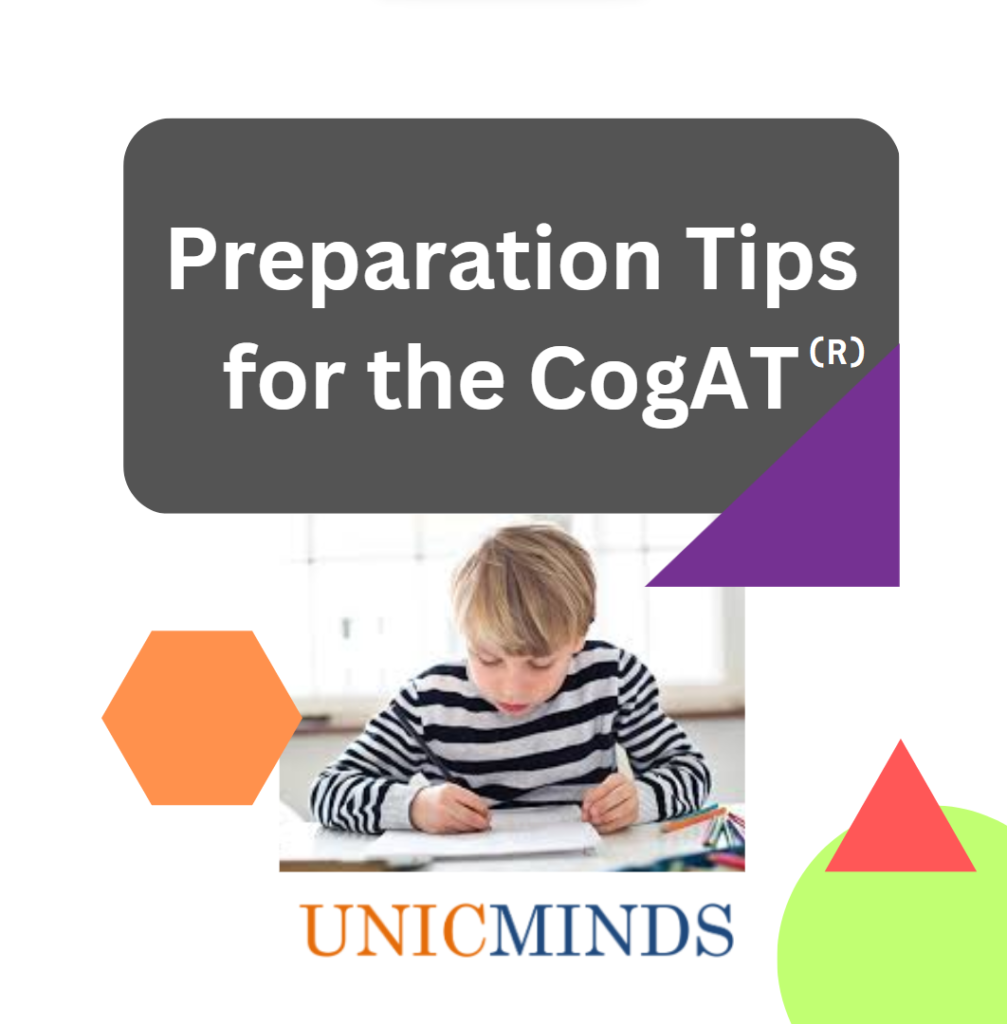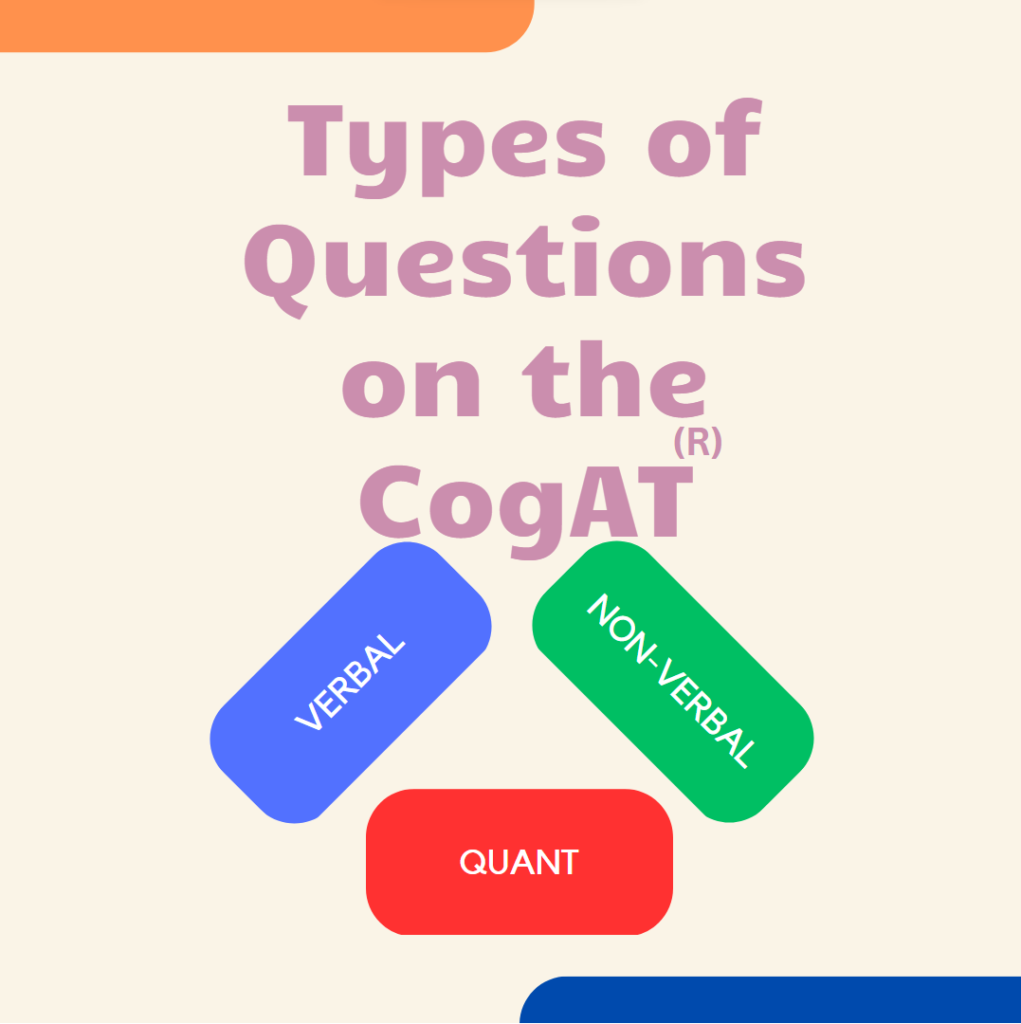The Cognitive Abilities Test (CogAT) measures the level and pattern of cognitive development of a student compared to age mates and grade mates. The CogAT is a nationally standardised test schools and educators use to identify gifted and talented students. In the earlier days, the only way to identify gifted students was by school grades, essentially knowledge. But, the right way to test students is more to test their “ability” than “knowledge”, and that is what CogAT tries to do. So, CogAT at its core is an ability test. The criteria for “gifted student” selection vary by states and even individual schools in the US, but most gifted and talented programs require testing in some form as a means of getting in.
The CogAT Test – Form 7 and Form 8
The CogAT test essentially has three sections: verbal, maths and non-verbal sections. The test is a multiple-choice based exam to assess students’ reasoning skills through verbal, nonverbal, and quantitative questions. Published by Riverside Insights, the CogAT was originally developed in the 1950s and has since gone through many updates. The most recent versions of the test are Form 7 and Form 8. Form 7 and Form 8 are equivalent tests (doesn’t have the same questions) – sometimes schools can use both to establish firmly the place of a student. Form 8 is the latest version and is known to include non-native speakers but otherwise don’t worry too much about the forms.
- The verbal section measures a child’s ability to remember and transform sequences of English words, to understand them and to make inferences and judgments about them. Verbal questions involve language, words, and life-like images.
- The quantitative section measures a child’s understanding of basic quantitative concepts, reasoning and relationships.
- The non-verbal section measures reasoning using pictures and geometric shapes. This section reduces the impact of language on the student’s score. Children must understand the commonality, relationships, similarities, differences, causations, sequences among different kinds of shapes, patterns, visual sequences, analogies, geometry of paper-foldings, punched holes and how it will look next in the sequence.
- The composite score is a total score for all three batteries.
Verbal Battery:
- Verbal Analogies
- Sentence Completion
- Verbal Classification
Quant Battery:
- Number Analogies
- Number Puzzles
- Number Series
Non-Verbal Battery:
- Figure Matrices
- Paper Folding
- Figure Classification
Is the exam text-based or picture-based?
To normalise for age-appropriateness, the exam is picture-based for younger kids (level 8 and below) and text-based for older kids (level 9 plus).
Which level to take?
The CogAT is divided by age level, meaning the Level 8 would generally be administered to children who are 8 years old, the Level 9 would be administered to children who are 9 years old, and so on. When beginning to prepare for the CogAT, it is very important that you find out from your school what level your child will be tested at, as schools can test above grade level to assess highly gifted students, or below grade level if they are testing at the beginning of the school year. In general, the picture shown below is how the CogAT’s test levels correspond to grade levels: A child who is 5 or 6 will take the CogAT Level 5/6. A 10-year-old will take Level 10, and so on.
Understanding the Scoring System:
The typical score-report looks like the following picture.
The first column “standard age score” shows the score of the kid relative to the other kids of same age. The SAS has a mean of 100 a deviation of 16. This means if a kid gets a SAS score of 100 on Verbal Battery, the kid has a rate and level of development of verbal reasoning skills that is typical of their age group. A student who has an SAS of 125 on the Verbal Battery has a faster rate and a higher level of development of verbal 2 reasoning skills than the typical student in the same age group.
The second column “age stantine” is a normalised ranking of levels. There are 9 levels on this “age stanine” rank scale; higher the better.
The third column “Age Percentile Rank” is the percentile score of the student. It indicates the number of students who fall below this student with this score. If you see a “60”, it means that 60% of the students are ranked below this student and approximately 40% are ranked above this student.
The Composite Score is a percentile for all three batteries. This number combines all three scores and indicates where your child stands by comparison to other students who took the test. Thus, a composite percentile score of 90 indicates that, overall, your child did better on all three sections combined than 90 percent of other students in her age group. It is usually encouraged to see the scores on three different batteries separately, rather than looking at the composite score which loses the sharpness of understanding of the kid.
The Pattern of Score is indicated one of the following ways:
A Profile: The student’s verbal, quantitative, and nonverbal scores are roughly at the sAme level.
B Profile: One of the three scores is either aBove or Below the other two. The student’s profile will either show a relative strength OR a relative weakness.
C Profile: There is one score above and one score below creating a Contrast. This student’s profile will show both relative strength and a relative weakness.
E Profile: If a B or C profile represents a point difference in the SAS score of 12 points or more, it is considered Extreme. An E profile calls attention to the scores difference.
Your child’s relative strength or weakness is indicated using plus or minus signs and letters. V stands for Verbal Battery, N stands for Nonverbal Battery, and Q stands for Quantitative Battery. A plus sign (+) following one of these letters signifies that your child demonstrated a relative strength on that battery. A minus sign (-), on the other hand, means that your child’s test showed a relative weakness in that particular area.
For example, a V+ indicates a relative strength on the Verbal Battery. A Q- indicates a relative weakness on the Quantitative Battery, and a V+Q- would mean that your child demonstrated relatively strong verbal reasoning skills and relatively weak quantitative reasoning skills. Students with A profiles will not have relative strengths or weaknesses, as their scores are consistent across all three batteries.
Understanding example scores below:
- 8A = Above average scores on all three batteries.
- 8B (V-) = Generally high scores with a relative weakness on the Verbal Battery.
- 8E (V-) = Generally high scores with an extreme weakness on the Verbal Battery.
- 6C (N+ Q-) = Generally average scores with a relative strength on the Nonverbal Battery and a relative weakness on the Quantitative Battery.
- 2B (Q+) = Generally below average scores, but a relative strength on the Quantitative Battery.
Conclusion
Approximately half of the students who take CogAT show a relative strength or a relative weakness in one of the three test batteries. Understanding this provides the opportunity to adapt instruction to build on the student’s strengths and shore up any weakness. Ability profiles with a V+, Q+, or N+ indicate a relative strength on the Verbal, Quantitative, or Nonverbal Battery, respectively. Ability profiles with a V–, Q–, or N– indicate a relative weakness on one of the three CogAT batteries.
It is important to understand that the CogAT, like many cognitive tests administered to children, is an imperfect assessment measure that can vary greatly depending on a variety of external factors. Thus, while these scores can be important, they should not be taken as the sole measurement of your child’s abilities and skills.
There are other countries like Canada and the United Kingdom that use a very similar variation of the CogAT in US. Canada uses the Canada Cognitive Abilities Test (CCAT) and United Kingdom uses the Cognitive Abilities Test (CAT4) and Standard Assessment Test (SAT). Otis Lennon School Ability Test (OLSAT) is also a similar test to the CogAT to test cognitive abilities that relate to success in school.
Hope this is useful, thank you.
Learn more about CogAT tutoring, exams, practice questions and more.
Book a free CogAT trial class with us.
If you’re looking for online teaching opportunities, then Jooble provides a wide range of remote teaching jobs both abroad and in the USA.
Disclaimer:
The Cognitive Abilities Test (CogAT or COGAT) are registered trademarks of Riverside Publishing.
OLSAT is a registered trademark of Pearson Education.
English Essentials: Understanding about Subject, Verb, Object, Predicate, Phrase, Clause, & Sentence




